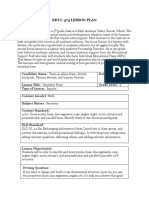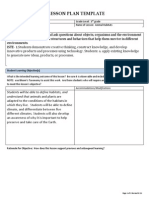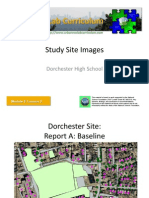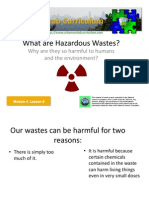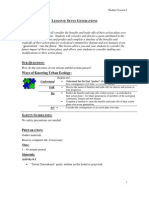Lesson 5: Land Use in My Field Site O: Verview
Lesson 5: Land Use in My Field Site O: Verview
Uploaded by
Urban EcoLab CurriculumCopyright:
Available Formats
Lesson 5: Land Use in My Field Site O: Verview
Lesson 5: Land Use in My Field Site O: Verview
Uploaded by
Urban EcoLab CurriculumOriginal Title
Copyright
Available Formats
Share this document
Did you find this document useful?
Is this content inappropriate?
Copyright:
Available Formats
Lesson 5: Land Use in My Field Site O: Verview
Lesson 5: Land Use in My Field Site O: Verview
Uploaded by
Urban EcoLab CurriculumCopyright:
Available Formats
Land Use in my Field Site
Module 2 Lesson 5
Lesson 5: Land Use in my Field Site OVERVIEW
This lesson explores how land is used in the students study site. Students will then go to their field site and collect tree, surface, and structure data. In the next activity students will make a map of how land is used in their field sites. Students will compare their field site to the surrounding area by using Google earth, focusing on green spaces and trees.
SUB-QUESTION:
How is land used in my study site?
WAYS OF KNOWING URBAN ECOLOGY:
Understanding Students will understand that
Various aspects of site must be considered when describing the land use of that site. No specific goals connected with talking about urban ecology in this lesson. Students will Collect ecological data in the field Use a dichotomous key to identify local tree species. Use Google Earth to learn about their study site. No specific goals connected with acting on urban ecology in this lesson.
Talking Doing
Acting
SAFETY GUIDELINES
Safety precautions associated with field visits
PREPARATION
Time: 2 class periods Day 1: Activity 5.1 Activity 5.2 Day 2: Activity 5.3 Activity 5.4 Materials Activity 5.1 Dichotomous Tree Guides Measuring Tape Copies of Student Sheets Activity 5.2
Land Use in my Field Site Copies of Student Data Collection Sheets Activity 5.3 Graph paper Colored Pencils Activity 5.4 Computers with Google Earth Copies of Student Sheets
Module 2 Lesson 5
INSTRUCTIONAL SEQUENCE
Activity 5.1: Characterizing Important Elements of the Site Tell students that today they are going to explore how land is used in their study site. The focus of this lesson is on improving the site. 1. Review concepts from the day before o Ask students what are some various ways that land is used? What are the reasons for different land uses? 2. Before students go outside they need to learn techniques on how to collect the data. The data on trees will not be explicitly used in this lesson but is important in module 8, and will therefore be collected in advance o In this activity, students will learn the basics of tree identification and measurement. Students will use a dichotomous key to identify trees, measure diameter at breast height, assess health, and growing conditions of the trees in their study site. These techniques will allow them to input data about their field site into a spreadsheet that calculates the economic and ecological value of trees in Module 8. 3. Tree Data o Dichotomous Key Teachers should acquire enough dichotomous tree guides for students to be able to work in groups of twos or threes.
A good (a cheap book) for identification of trees is: Tree Finder: A Manual for the Identification of Trees by Their Leaves (Nature Study Guides) by May T. Watts($3.50) There is also several on-line resources one of which is: (Free) http://www.urbanecologyscience.org/files/trees/Flash/bc_tree_id.swf Discuss with students the process of using a dichotomous key. Inform students that different trees have different economic and environmental benefits so it is important that we know what kinds of trees are in our study site in order to calculate their effect.
Land Use in my Field Site
Module 2 Lesson 5
Teaching Strategy If your students have not identified trees before it is helpful to: 1. Bring in leaves from two trees and have your students identify them before going out to the field. 2. You should make sure that the students understand at least the following major tree identification aspects before going out to the field: a. Simple or Compound b. Alternate and Opposite branching Being able to determine whether you tree has simple or compound leaves and whether it is alternate or opposite branching can narrow your tree identification significantly. Some students also struggle with pinnately and palmately veined leaves so you may want to discuss that as well. To help students practice the steps necessary to using a dichotomous key, bring in several cuttings of trees branches to allow students to practice. To help students understand the process of using the key, it may help to walk through an identification of a branch using the dichotomous key as a whole class. Allow students to work together in twos and threes to identify the tree cuttings. As each group of students finishes identifying the tree branches, have them switch cuttings with other groups. o Diameter at breast height Distribute the student instructions on how to measure the diameter at breast height (DBH). If time and weather allows, go outside to practice measuring DBH. This is also a good time for students to try using their dichotomous keys to identify trees. If weather does not permit, have students practice measuring DBH of circular objects in your classroom (e.g. Basketball, soccer ball, lampshade, etc). Tip: figure out the DBH of several trees in your study site ahead of time and mark them. Ask students to find the DBH of these trees and report back to you. In this way you can determine if your students are correctly calculating DBH. o Growing Conditions Distribute the student instructions for assessing growing conditions. The growing conditions impact the economic value and environmental impact of the tree. Student data will be added to the spreadsheet calculations of tree value.
Land Use in my Field Site
Module 2 Lesson 5
o Health Conditions Distribute the student instructions for assessing health conditions. The health conditions impact the economic value and environmental impact of the tree. Student data will be added to the spreadsheet calculations of tree value. o Distance and Direction from the building You will need measure the distance the tree is from the building. If the tree is greater than 25 feet from the building then it contributes nothing to energy savings to that building. Students will also need to document the direction the tree is from the building. Trees provide more energy savings if they are on the west or south side of a building. 4. Along with the tree data students will also need to document and measure important aspects of their field site o Impervious Surfaces- surfaces that are not penetrable by water. What types of surfaces are they? Where are they located? How much space do they take up? What is it used for? o Open (green) space- Where is it located? How much space is it? What is it used for? o Man made structures, ex: statue, flagpole, fence, playground, ect. Where are they located? How much space do they take up? What is it used for? 5. Students should also make a sketch of the field site to help them when they go to make their maps. Activity 5.2 Collecting Data In this activity, students will take the skills they learned in the previous section and apply them as they begin to catalog the way land is used and the trees in their study site. 1. Students should work in groups of two or three. Each group should have a dichotomous key and a tape measure (or string and a ruler), in addition to a clipboard with the data sheet and student worksheets on DBH, growing conditions, and health. 2. Allow students to walk around the study site. An area should be defined so students know what to include. 3. Remember to orient the students they will need to know if the tree is north, south, east, or west of the school. 4. Students also need to estimate the height of the tree. A rough estimate is acceptable. Have students compare the tree to the height of a nearby utility pole the poles are usually between 20 and 40 feet tall (most are 30 feet). 5. Students also need to estimate the amount of space each surface or structure takes up. They can do this by waking each side of the space counting the number of steps they took. One step is approximately equal to one foot. Area can then be calculated. 6. It is very important that students DO NOT lose their tree data. It is needed for an activity in the last module.
Land Use in my Field Site
Module 2 Lesson 5
Concluding Day 1 1. Bring students back together and back to the classroom 2. Discuss the students experience. Did anything surprise you? How was land used in the field site? Activity 5.3 Mapping land use in their field site 1. Students should take out their data collection sheets and sketch from the day before 2. Students will construct a map of land use in their field sites on a piece of graph paper. Students should use their sketch as a reference but their maps should reflect their data collection. 3. Students should create a scale that reflects their own measurements 4. Students should include a North arrow on their maps 5. Students should also include a legend on their maps. The maps should reflect the differences in land use in either shapes or color, and the legend should clarify the students choices. If you want to have the student distinguish between different types of surfaces and trees this should also be included in the legend. Activity 5.4 Google Earth Students can use Google Earth on a computer to compare their field study site to the greater area. (There are different versions of Google Earth available, so these steps & instructions may not work as stated with all versions. You should explore Google Earth a bit to make it work for your situation before doing this exercise with your students.) 1. Ask students if they know where the open spaces nearest to their study site are. How might open spaces benefit humans? How might open spaces benefit animals? Then describe how Google Earth works. 2. Have students work individually or in pairs at a classroom computer to use Google Earth to locate their study site and nearby open spaces. o As a class you may want to define open space. Remind students that recreational areas can count as open space. 3. As a class, discuss students answers to the critical thinking questions. Teacher Background Knowledge Mac Adaptation 1. May need different version of Google Earth. If your Mac doesnt have OSX4., the latest version of GE wont work. Youll need to download a previous version of GE. Even if you do have the latest version of OS X (or whatever comes after the books publication date), the format of the GE website may continue to look different from the PC version. 2. For the Mac equivalent of PC instruction 2, there is no Local Search tab on previous GE versions. Instead, if you know the address, go to the Fly To tab, type in the address, including the ZIP code and country and press return. 3. After GE has found your study site, without typing anything else, locate the circular zoom and tilt icon on your screen. Explore the Zoom, Tilt, and Drag controls to become familiar with the computer site. 4. The Placemark tack icon may be in a different place on your Mac screen than on
Land Use in my Field Site
Module 2 Lesson 5
5. 6. 7. 8.
the PC screen. When you find it, click on the tack icon. Type in the name of your study site in the Name Google Earth - New Placemark box that opens up on the screen. Type in a brief description of the site. Same as PC instructions: Click on the Placemark tack icon to the right of the study site name, and chose a new icon to designate your study site with a click on the new icon. Scroll down to the bottom of the Mac screen and find the OK button. You MUST click on the OK button in order to save your new place marker. The rest of the directions should be similar to the PC instructions, with the exception that you have to follow the Mac instructions to place another icon. Also, later versions of PC and Mac platforms (and any others) may allow other measurements. The Mac version allows for a Path measurement as well as a line measurement. Future measurements may include area.
Common Student Misconception A common misconception that students may have is that urban areas will have little to no open space. In general, urban areas do have less open space than non-urban areas. However it is important that students begin to recognize that urban areas do have open spaces. In fact there are significant benefits of open space. These benefits include increased investment by business, increased economic activity, attraction and retention of residents and more tourism. Concluding 1. How might land use patterns (esp. trees and open spaces) differ between an urban and suburban area? On Google Earth, search a nearby suburb if you live in a city; and if you live in a suburb, search a nearby city. Discuss the similarities and differences as a class.
Land Use in my Field Site
Module 2 Lesson 5
Tree Data Collection Form
Name: __________________________ Date: ____________ Class Period: _____________ Study Site: _____________________ Tree ID Number Species (Common name) Trunk Diameter at breast height (inches) Height (estimate in feet, optional) Direction from Building Distance from Building (feet) Health Class Growing Conditions
Direction from Building East West North South
Growing Conditions 1 = Poor 2 = Fair 3 = Good
Health Class 1 = Dead/Dying 2 = Poor 3 = Fair 4 = Good 5 = Excellent
Land Use in my Field Site
Module 2 Lesson 5
Name: _______________________________Date: _________Class/Period:________ Types of Surfaces Type of surface (if surface exists more than once list it more than one) Grass Description of location Estimated area (ft2) Can Water Infiltrate Through? (Yes or no) Yes Purpose of space
Between the building and parking lot
100 ft2
Recreational
Types of Structures Type of Structure Playground Description of Location In open grassy space about 30ft from the building Estimated Area (ft2) 20 ft2 Purpose of Space Recreational
Land Use in my Field Site
Module 2 Lesson 5
Land Use in my Field Site
Module 2 Lesson 5
TREE HEALTH EVALUATION SHEET
If the tree has:
a live top (live crown) that does not show signs of excessive pruning (the shape of the crown is normal). newly dead branches that make up less than 15% of the total crown foliage that is dense throughout the live portion of the crown a tree trunk with open wounds that are less than one-third the diameter of the tree, no wounds in contact with the ground, and no wounds that have soft, mushy wood (an indication of decay) If the tree has a wound and it is soft, mushy, wet or stained If the tree has a wound and you observe insects living in the tree If the tree has a wound that is hard, and surrounded by a uniform raised ring of bark. (If yes, this wound is likely to callous over completely and mostly healed) Tree roots are lifting the sidewalk, appear damaged, or showing signs of decay Total Points Use the following table to evaluate your tree. Category Tree is in EXCELLENT condition Tree is in GOOD condition Tree is in FAIR condition Tree is in POOR condition Points 4+ points 3+ points 1-2 points Less than 1 point Then add 1 point add 1 point add 1 point add 1 point
Subtract 1 point Subtract 1 point Add 1 point Subtract 1 point
Record your results on your data collection sheet.
Land Use in my Field Site
Module 2 Lesson 5
GROWING CONDITIONS WORKSHEET
Use the below table to guide you as you evaluate the growing conditions of each tree in your study. Be sure to record your final evaluation on your tree data collection sheet.
If the tree:
Has access to plenty of sunlight (not competing a lot with other trees for sunlight) Is not obstructed by power lines, other trees, buildings or another structure Is surrounded by soil that is loose and will allow water to enter (noncompacted soil). There appears to be enough soil available for the tree root structure to grow (if the tree is lifting up the sidewalk or displacing other objects near it then the tree probably needs more space) The tree does not have guy wires (wires tied around the trunk to keep the tree from moving) or a tree grate (a metal grate around the base of the tree) Tree is near a road or other area that can lead to damage Tree is either in good or excellent health Tree is dead or in fair or poor health Total Points
Then add 1 point add 1 point add 1 point add 1 point Add 1 point Subtract 1 point Add 1 point Subtract 1 point
Use the following table to evaluate the growing conditions for your tree Category GOOD growing conditions FAIR growing conditions POOR growing conditions Points 4 6 points 1-3 point Less than 1 point
Record your results on your tree data collection sheet.
Land Use in my Field Site
Module 2 Lesson 5
MEASURING THE DIAMETER OF A TREE
What do I need?
You will need the following items to measure the diameter of your tree. measuring tape You need a partner to help you with this activity. Data collection sheet
Instructions: How do I measure the diameter of a tree?
Step 1: Measuring the Diameter Breast Height (DBH) The diameter of a tree at 4-1/2 feet above the ground is called the "diameter at breast height" (DBH). Stand on the uphill side of the tree and find a point 4.5 feet up the trunk. Wrap your tape measure around the tree at this point. Note you are measuring circumference not diameter at this point!
What if my Tree Forks? If the tree forks below 4.5 feet then measure the circumference of the largest stem at 4.5 feet to the nearest inch. If the tree forks at 4.5 feet, then measure the circumference at the smallest place below the fork. The best tool to use to measure circumference is a flexible tape measure - or one can use a non-stretch string and a ruler. To ensure an accurate measurement make sure the tape or string is perpendicular to the axis of the trunk and is not twisted. Remember that all circumference measurements need to be made in inches. Make sure you record your results in on your data table. What if my Tree has lots of stems and branches? If the tree has multiple stems, measure the diameter of all the stems and then add all your measurements together to get an estimate of the trees diameter.
Land Use in my Field Site Step 2: Determining diameter of your tree
Module 2 Lesson 5
So far you have measured the circumference of the tree - not the diameter. To convert your measurement into diameter units use the following formulas: Circumference = 2 ** radius And the diameter of the tree is 2 * radius So Radius = Circumference/ (2 ) And Diameter of tree = 2 * radius For instance, if we knew the circumference of our tree was 12 inches, we would divide 12 by 2 (12/ 2 = 1.9). Then we would multiply our answer by 2 (1.9 x 2 = 3.8). Then we would have our diameter 3.8 inches.
If your calculator does not have the function, use 3.14.
Land Use in my Field Site
Module 2 Lesson 5
Name: ________________________________Date: _________Class/Period:________
Activity 5.4: Google Earth
You can use Google Earth on a computer to locate your field study site on an aerial photomap (taken by satellites for Google Earth recently). Using Google Earth you can compare the land use of your field site to the land use in the surrounding area. You will also be able to find the distances between your field site and nearby parks and open spaces where similar tree communities may be found. Procedures: 1. Open Google Earth 2. Under the Fly To tab enter the address of your field site. 3. Once you are zoomed in on your site compare the image to the map you made. How are they similar? How are they different?
4. Go to the tool bar at the top of the page and select View. Under view click on Scale Legend. A scale bar, in ft, should appear at the bottom left corner of the image. Slowly zoom out until you double the number in ft. 5. How do the trees in the surrounding area compare to your field site? Are there more trees? Fewer trees?
6. Slowly zoom in until you again double your number in ft. How does the amount of open space in the surrounding area compare to your field site. Are the spaces larger or smaller? How many open spaces do you see?
7. Go to the tool bar at the top of the page and select Tools. Under tools click on Ruler. Click on your field site and draw a line to the nearest open green space. How far away is it?
Land Use in my Field Site
Module 2 Lesson 5
8. Describe how land is used in the area surrounding your field site. Is there development (houses, buildings, roads)? Are there any bodies of water?
Critical Thinking Questions 1. How is land used in the area surrounding your field site? Is this similar or different to the way land is used in your field site?
2. What are some advantages to having trees and open spaces? What are some disadvantages?
3. What are some limitations to the way land is used? What should people consider before making land use decisions?
Land Use in my Field Site
Module 2 Lesson 5
Name:___Teacher________________________Date:________Class/Period:________ Activity 5.4: Google Earth
You can use Google Earth on a computer to locate your field study site on an aerial photomap (taken by satellites for Google Earth recently). Using Google Earth you can compare the land use of your field site to the land use in the surrounding area. You will also be able to find the distances between your field site and nearby parks and open spaces where similar tree communities may be found. Procedures: 1. Open Google Earth 2. Under the Fly To tab enter the address of your field site. 3. Once you are zoomed in on your site compare the image to the map you made. How are they similar? How are they different? The Google Earth image may have been taken at a different time of the year, therefore resulting in possible differences. The image may also be a few years old so there may be some differences in trees/ vegetation and structures. This question is just to help the students realize that land use could have changed from when the image was taken to when they are conducting their study. 4. Go to the tool bar at the top of the page and select View. Under view click on Scale Legend. A scale bar, in ft, should appear at the bottom left corner of the image. Slowly zoom out until you double the number in ft. 5. How do the trees in the surrounding area compare to your field site? Are there more trees? Fewer trees?
6. Slowly zoom in until you again double your number in ft. How does the amount of open space in the surrounding area compare to your field site. Are the spaces larger or smaller? How many open spaces do you see?
7. Go to the tool bar at the top of the page and select Tools. Under tools click on Ruler. Click on your field site and draw a line to the nearest open green space. How far away is it?
Land Use in my Field Site
Module 2 Lesson 5
8. Describe how land is used in the area surrounding your field site. Is there development (houses, buildings, roads)? Are there any bodies of water?
Critical Thinking Questions 1. How is land used in the area surrounding your field site? Is this similar or different to the way land is used in your field site? Answers will vary depending on the site and surrounding area.
2. What are some advantages to having trees and open spaces? What are some disadvantages? Answers will vary. Some possible advantages of having trees and open spaces may be a larger amount of animals, and the ability of the animals to travel between open spaces. Another advantage is having more recreational opportunities. Some disadvantages of having trees and open spaces is that it prevents development or might make it more costly to expand development.
3. What are some limitations to the way land is used? What should people consider before making land use decisions? Answers will vary. There are many limitations to the way land is used. First it might depend on the natural land itself: materials, water bodies, elevation. Cost is another important limitation to the way land is used. There are many considerations to take in mind before making land use decisions. You need to
Land Use in my Field Site
Module 2 Lesson 5
understand the limitations of the land. It is also important to know the purpose of using land in a certain way (like having open spaces for recreation).
You might also like
- Lesson Exemplars TLE6AG Oc 4Document14 pagesLesson Exemplars TLE6AG Oc 4Teacher AppleNo ratings yet
- Udl Lesson Plan - Ed 4702Document6 pagesUdl Lesson Plan - Ed 4702api-242345831No ratings yet
- Math Inquiry LessonDocument4 pagesMath Inquiry Lessonapi-409093587No ratings yet
- Methods and Techniques in Urban Engineering PDFDocument270 pagesMethods and Techniques in Urban Engineering PDFKevinDeivoroCristobalNo ratings yet
- Lesson 9: From Seed To Growing Tree: G3Q4 - Plants and Trees UnitDocument10 pagesLesson 9: From Seed To Growing Tree: G3Q4 - Plants and Trees Unitapi-246719434No ratings yet
- 3rd Grade Plants - Final Version - Web PDFDocument78 pages3rd Grade Plants - Final Version - Web PDFAbdirazzak Osman YousufNo ratings yet
- Math Lesson-Changing GardenDocument4 pagesMath Lesson-Changing Gardenapi-241180594No ratings yet
- Lesson Three - HillsDocument3 pagesLesson Three - Hillsapi-283707491No ratings yet
- Art Integration Lesson Plan Template: (Please Circle)Document5 pagesArt Integration Lesson Plan Template: (Please Circle)api-302379773No ratings yet
- Lesson Plan For PortfolioDocument3 pagesLesson Plan For Portfolioapi-356975003No ratings yet
- Unit Plan SciDocument12 pagesUnit Plan Sciapi-375583691No ratings yet
- Biomes Lesson PlanDocument3 pagesBiomes Lesson Planapi-268661281No ratings yet
- Science Methods Lesson Plan-MadisonDocument5 pagesScience Methods Lesson Plan-Madisonapi-513604833No ratings yet
- Science: Biomes Lesson PlanDocument5 pagesScience: Biomes Lesson Planapi-281903910No ratings yet
- Teacher NotesDocument3 pagesTeacher NotesPavle MilenkovicNo ratings yet
- Thursday LessonDocument4 pagesThursday Lessonapi-372343626No ratings yet
- What Is The Bird Biodiversity of Our Field Site?Document7 pagesWhat Is The Bird Biodiversity of Our Field Site?Urban EcoLab CurriculumNo ratings yet
- Second Grade Science LessonDocument9 pagesSecond Grade Science Lessonapi-591042996No ratings yet
- Assure Model Instructional PlanDocument4 pagesAssure Model Instructional Planapi-3799631510% (1)
- Soil Texture Lab 2Document3 pagesSoil Texture Lab 2api-436971039No ratings yet
- Dborum Lesson PlanDocument6 pagesDborum Lesson Planapi-284297058No ratings yet
- Earthdayyear 6Document9 pagesEarthdayyear 6api-250695989No ratings yet
- Lesson Plan 1 Earth Day HoorayDocument4 pagesLesson Plan 1 Earth Day HoorayMelissaNo ratings yet
- Parts of A Plant UbdDocument6 pagesParts of A Plant Ubdapi-252823406No ratings yet
- To TeachersDocument4 pagesTo Teachersapi-395538070No ratings yet
- Lesson Plan Template ltc4240Document6 pagesLesson Plan Template ltc4240api-272840272No ratings yet
- Scienceunitplanner-Threesessions FinalisedDocument10 pagesScienceunitplanner-Threesessions Finalisedapi-268951514No ratings yet
- Lesson Plan 5-2Document4 pagesLesson Plan 5-2api-406857834No ratings yet
- Earth Science 5e Lesson PlanDocument4 pagesEarth Science 5e Lesson Planapi-545793045No ratings yet
- ELL Tech Tools Lesson PlanDocument5 pagesELL Tech Tools Lesson PlanRuthNo ratings yet
- Sample Direct Lesson PlanDocument4 pagesSample Direct Lesson Planmbatalis1894100% (1)
- Lesson Plan 3Document3 pagesLesson Plan 3api-335570406No ratings yet
- UbdDocument4 pagesUbdapi-284300618No ratings yet
- LPDocument4 pagesLPapi-24701822750% (2)
- HabitatslessonasDocument5 pagesHabitatslessonasapi-249553488No ratings yet
- Lesson Plan TemplateDocument4 pagesLesson Plan Templateapi-252189364No ratings yet
- Educ4720 Differentiation Assignment 2Document8 pagesEduc4720 Differentiation Assignment 2api-287133983No ratings yet
- Unit 2 Lesson 1Document3 pagesUnit 2 Lesson 1api-240273723No ratings yet
- Plant Unit PlanDocument20 pagesPlant Unit Planvangelib0% (1)
- Lpp2final Hesseltine ClaireDocument10 pagesLpp2final Hesseltine Claireapi-535000563No ratings yet
- Direction: Read The Following Statements. Choose The Letter of The Correct AnswerDocument14 pagesDirection: Read The Following Statements. Choose The Letter of The Correct AnswerRosario Ingalla100% (6)
- Lesson Plan 4 ScienceDocument5 pagesLesson Plan 4 Scienceapi-242017773No ratings yet
- UbdwassessmentsDocument7 pagesUbdwassessmentsapi-239876044No ratings yet
- Bing Alexis-Lessonplan1finalDocument8 pagesBing Alexis-Lessonplan1finalapi-666001481No ratings yet
- Smartin-Lessonplan-Iste - Spring2016Document29 pagesSmartin-Lessonplan-Iste - Spring2016api-317391078No ratings yet
- Matrix Et 347Document4 pagesMatrix Et 347api-308501563No ratings yet
- Erosion Lesson PlanDocument4 pagesErosion Lesson Planapi-297180060No ratings yet
- Worm Activity Lesson PlanDocument5 pagesWorm Activity Lesson Planapi-272317458No ratings yet
- Lesson Plan Plant CareDocument3 pagesLesson Plan Plant Careapi-300472292100% (1)
- Pecot Science Lesson PlanDocument3 pagesPecot Science Lesson Planapi-534405902No ratings yet
- Social Dec 8Document5 pagesSocial Dec 8api-297100127No ratings yet
- Plants Mini Fieldtrip-Lesson4Document3 pagesPlants Mini Fieldtrip-Lesson4api-240589503No ratings yet
- Lesson Plan 7. Farm Plans and Layout BergadoDocument8 pagesLesson Plan 7. Farm Plans and Layout BergadoJenny MocorroNo ratings yet
- URL Link To The Lesson Plan Reviewed IsDocument4 pagesURL Link To The Lesson Plan Reviewed Isapi-355180119No ratings yet
- Plants and How They Grow Unit PlanDocument9 pagesPlants and How They Grow Unit Planapi-300190285No ratings yet
- Edu 220 1 Common Core Lesson PlanDocument2 pagesEdu 220 1 Common Core Lesson Planapi-350119661No ratings yet
- Science Lesson in The BoxDocument6 pagesScience Lesson in The Boxapi-340404014No ratings yet
- Lesson Plan For Implementing NETS - S-Template I: (More Directed Learning Activities)Document5 pagesLesson Plan For Implementing NETS - S-Template I: (More Directed Learning Activities)api-284834403No ratings yet
- Design Topic Geometry Subject(s) Measurement Grade(s) 5 Designer(s) Amber Plowman Understanding by DesignDocument7 pagesDesign Topic Geometry Subject(s) Measurement Grade(s) 5 Designer(s) Amber Plowman Understanding by Designapi-562371166No ratings yet
- Assure Lesson Plan PDFDocument4 pagesAssure Lesson Plan PDFapi-337261174No ratings yet
- M1 L1 T Contingency CardsDocument1 pageM1 L1 T Contingency CardsUrban EcoLab CurriculumNo ratings yet
- M6 L3 FinalDocument3 pagesM6 L3 FinalUrban EcoLab CurriculumNo ratings yet
- Taking Action For Environmental Sustainability - : RecicladoresDocument6 pagesTaking Action For Environmental Sustainability - : RecicladoresUrban EcoLab CurriculumNo ratings yet
- L 6: F C C C O:: How Do Our Food Choices Impact Energy Use?Document9 pagesL 6: F C C C O:: How Do Our Food Choices Impact Energy Use?Urban EcoLab CurriculumNo ratings yet
- M8 L3 Impact TreesDocument7 pagesM8 L3 Impact TreesUrban EcoLab CurriculumNo ratings yet
- M5 L2 Health& CultureDocument7 pagesM5 L2 Health& CultureUrban EcoLab CurriculumNo ratings yet
- What Is Type 2 Diabetes: Module 5 Lesson 7Document9 pagesWhat Is Type 2 Diabetes: Module 5 Lesson 7Urban EcoLab CurriculumNo ratings yet
- M5 L9 Income& HealthDocument7 pagesM5 L9 Income& HealthUrban EcoLab CurriculumNo ratings yet
- M2 L6 FinalDocument3 pagesM2 L6 FinalUrban EcoLab CurriculumNo ratings yet
- M7 L8 2010Document7 pagesM7 L8 2010Urban EcoLab CurriculumNo ratings yet
- M6 L2 Power Point AlternativeDocument4 pagesM6 L2 Power Point AlternativeUrban EcoLab CurriculumNo ratings yet
- M3 L4 Carbon CycleDocument6 pagesM3 L4 Carbon CycleUrban EcoLab CurriculumNo ratings yet
- M4 - L7 Lead in The EnvDocument12 pagesM4 - L7 Lead in The EnvUrban EcoLab CurriculumNo ratings yet
- M5 L2 Health& CultureDocument7 pagesM5 L2 Health& CultureUrban EcoLab CurriculumNo ratings yet
- M4 L4 PPT Hazwastes FinalDocument12 pagesM4 L4 PPT Hazwastes FinalUrban EcoLab CurriculumNo ratings yet
- Where Does Garbage Go in Massachusetts?: Module 4 Lesson 2Document6 pagesWhere Does Garbage Go in Massachusetts?: Module 4 Lesson 2Urban EcoLab CurriculumNo ratings yet
- M4 L8 WatershedsDocument4 pagesM4 L8 WatershedsUrban EcoLab CurriculumNo ratings yet
- M3 L2 Greenhouse EffectDocument8 pagesM3 L2 Greenhouse EffectUrban EcoLab CurriculumNo ratings yet
- M3 L4 CarbonCycle& HumanImpactDocument2 pagesM3 L4 CarbonCycle& HumanImpactUrban EcoLab CurriculumNo ratings yet
- M1 - L9 - Acting On Urban EcologyDocument9 pagesM1 - L9 - Acting On Urban EcologyUrban EcoLab CurriculumNo ratings yet
- M3 L3 Global Warming FinalDocument4 pagesM3 L3 Global Warming FinalUrban EcoLab CurriculumNo ratings yet
- New Orleans: A Case StudyDocument7 pagesNew Orleans: A Case StudyUrban EcoLab CurriculumNo ratings yet
- M1 L8 CitiesDocument14 pagesM1 L8 CitiesUrban EcoLab CurriculumNo ratings yet
- L 6: S G O:: How Do The Outcomes of Our Actions Unfold As Time Passes?Document5 pagesL 6: S G O:: How Do The Outcomes of Our Actions Unfold As Time Passes?Urban EcoLab CurriculumNo ratings yet
- M1 L3 SeasonsSnapshotsDocument2 pagesM1 L3 SeasonsSnapshotsUrban EcoLab CurriculumNo ratings yet
- Long Lesson Plan 1 Unit 1 - Education at SchoolDocument7 pagesLong Lesson Plan 1 Unit 1 - Education at Schoolapi-269506025No ratings yet
- Journal 5 2Document32 pagesJournal 5 2Naos2015100% (2)
- Lab Report Format: Objective/Problem StatementDocument2 pagesLab Report Format: Objective/Problem Statementjosephmontalvo93No ratings yet
- Manual For Innovative Pedagogy in STEM ContentsDocument134 pagesManual For Innovative Pedagogy in STEM ContentsdanyjorgeNo ratings yet
- (8626) Assignment 1Document13 pages(8626) Assignment 1Nimra KhurramNo ratings yet
- sm2h Website Term 3Document3 pagessm2h Website Term 3api-318188489No ratings yet
- eINDIA 2010 Partners DirectoryDocument76 pageseINDIA 2010 Partners Directorysaurs2No ratings yet
- Tall Tales Lesson 3-2Document3 pagesTall Tales Lesson 3-2api-314291919No ratings yet
- Official Recognition of Kenyan Sign LanguageDocument10 pagesOfficial Recognition of Kenyan Sign LanguageJack OwitiNo ratings yet
- Cartoon DrawingDocument22 pagesCartoon DrawingDalionzo100% (4)
- Article Review Reading Dewey: Interpretations For A Postmodern Generation by Larry A. HickmanDocument16 pagesArticle Review Reading Dewey: Interpretations For A Postmodern Generation by Larry A. HickmanElijah Miraflor-SantosNo ratings yet
- RGPV 1 Sem Schedule PDFDocument1 pageRGPV 1 Sem Schedule PDFAnonymous AIM0T0yNo ratings yet
- 6th DLP Past ConditionalDocument5 pages6th DLP Past Conditionalanon_732395672No ratings yet
- Content Knowledge and PedagogyDocument5 pagesContent Knowledge and PedagogyNICHOLE DIANNE DIME. DIAZNo ratings yet
- Hessah Obaid Saeed Sultan Alali: EducationDocument3 pagesHessah Obaid Saeed Sultan Alali: Educationapi-302806982No ratings yet
- Communications For Development and International Organisations in PalestineDocument128 pagesCommunications For Development and International Organisations in PalestineShehab ZahdaNo ratings yet
- Factors Influencing Product Involvement Among Young ConsumersDocument18 pagesFactors Influencing Product Involvement Among Young ConsumersdomsemacaNo ratings yet
- Class Boys Girls Total: Shaalasiddi Offline Format (2019-20)Document5 pagesClass Boys Girls Total: Shaalasiddi Offline Format (2019-20)லட்சுமணன் சுNo ratings yet
- Bus - Boycott - QuizDocument13 pagesBus - Boycott - Quizapi-503236378No ratings yet
- Ms Office-Pub Workout RubricDocument1 pageMs Office-Pub Workout Rubricapi-263852476No ratings yet
- On-Line Module #3a Time Managment & Study SkillsDocument18 pagesOn-Line Module #3a Time Managment & Study Skillssami karemNo ratings yet
- Leslie Sheldon-Evaluating Elt Textbooks and MaterialsDocument10 pagesLeslie Sheldon-Evaluating Elt Textbooks and Materialsfgousios100% (6)
- Edgar Dale PDFDocument11 pagesEdgar Dale PDFSabri Alkan100% (1)
- Focus Charting 2Document65 pagesFocus Charting 2Ella Caro100% (1)
- M14 Software Process Management Exam Paper Coventry UniversityDocument15 pagesM14 Software Process Management Exam Paper Coventry UniversitySaud Ab AljaloudNo ratings yet
- Spanish Verbs SER and ESTARDocument4 pagesSpanish Verbs SER and ESTARdwels002No ratings yet
- Cassie Marshall Resume - FinalDocument2 pagesCassie Marshall Resume - Finalapi-271732549No ratings yet
- 9 December 2019Document6 pages9 December 2019Sacred Heart Academy of La LomaNo ratings yet
- Don Bosco Pugad Annual Accomplishment Report 2011 I. Case ManagementDocument19 pagesDon Bosco Pugad Annual Accomplishment Report 2011 I. Case ManagementMuhamadAgusNo ratings yet


